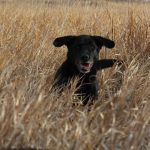By Ryan Eder
You can have the best marking dog in the world or the best handling dog in the world. But if he doesn’t sit, it doesn’t matter. Nothing can disrupt your hunt, or your quest for hunt test and field trial ribbons more than a dog with steadiness issues. Trust me. I know.
The truth is, we tend to contribute to these issues unknowingly in the way we work with our dogs (in and out of the field). Before we discuss a few basic drills you can do to work on steadiness, let’s identify common mistakes we make as handlers that contribute to steadiness issues in our dogs.
Prerequisites… and Some “Don’ts”
Basic Obedience: A dog that breaks in the blind is violating the most basic (yet arguably the most important) command: sit. Make sure your dog’s basic obedience is solid.
Place Board: Not everyone uses a place board, but the message is very clear to the dog that this is the area he must stay. This lesson transitions nicely into steadiness drills and, of course, the blind. An old mud flap from a semi-truck can work just fine; others use rubber shoe mats or even build them out of wood.
Exposure to Birds and Gunfire: With young dogs, too much exposure to birds can work against the steadiness we ultimately hope to attain. We definitely want to introduce our dogs to birds and guns to properly to establish a certain comfort level; but we cannot overdo it or we will see dogs begin to associate birds and guns with far too much excitement.
Too Many Retrieves: It is very common for dog owners to exhaust their puppies with several retrieves per day. This is not ideal; even dogs with enough drive to do this are conditioned to go retrieve everything they see fall. Later, this can contribute to steadiness issues. Not everyone will agree, but I think a few retrieves per week will do the trick.
Group work: Even though these articles are primarily about working alone, do your best to get your dog exposed to working around other dogs. The ability to sit patiently while another dog is working close by is a must in the field and especially at trials and tests. Early exposure to patience and good manners is always a plus!
Hunting Too Soon: While we all want to get our dogs in the field as soon as possible, hunting young dogs too soon can have more negative effects than positive. Most dogs under one year of age lack the maturity needed in the field. Have all of your basic training completed before your dog is put in a live hunting situation, and for a dog’s first season, it is a good idea to tie him up in the blind to prevent any breaking issues. This will pay off in the long run, trust me!
Steadiness Drills
Basic obedience: Our work here is never done! Even Michael Jordan shot free throws in practice. Revisit your basic obedience commands and challenge your dog by making him sit for extended periods of time with distractions and temptations.
Remote marks: Place your dog in the sit position, then walk out ahead of him with birds or bumpers. Throw single marks, but change things up:
- Delayed Sends: After the bird or bumper lands, do not send your dog right away. Pause on purpose to challenge his steadiness. If the dog demonstrates steady behavior, reward him with a send for the mark. Be careful with waiting too long, however — we do not want to start bad habits such as head-swinging (dog starts to look elsewhere anticipating another fall). All we are doing in this drill is establishing control and teaching our dog that he does not decide when he gets to make the retrieve.
- Denied Sends: For young dogs, simply making him watch marks being thrown without the reward of the retrieve is a great way to build patience and understanding of the fact that “not all birds are for me.” Throw your mark as you normally would, let the dog focus and mark the fall, and then go pick up the bird (or bumper) yourself.
Watch your dog for his rear end lifting off the ground, any movement with the front feet (pitter-patter), creeping (scooting forward), crouching (leaning forward bringing his underside toward the ground), or even vocal behavior.
For corrections, keep in mind that you are throwing these marks remotely, so you are not going to be near him to use a heeling stick to correct any non-steady behavior. You can move toward the dog and re-sit him (using a heeling stick to reinforce the sit command is okay here). The act of walking toward the dog to correct him can sometimes be enough, and, of course, keep in mind he did not get to retrieve the mark, which is often punishment enough. Depending on your dog’s experience level and training, using the electronic collar to reinforce the sit command (or possibly discourage unwanted vocal behavior) during this drill is another option.
Diversions: A duck blind can be chaotic to say the least, and a solid duck dog needs to be able to be around all kinds of distractions but remain focused on the job. Realize that much of this comes with experience; but how we train impacts how well a dog handles these diversions. As our dogs age and progress in training, we want to think about incorporating the following into our drills (again, young dogs should not be overexposed): calling, gunfire, secondary falls (another bird falling while our dog is retrieving another) without switching.
Clip-winged Birds: One of my favorite steadiness drills for training alone is throwing clip-winged birds in very close proximity to my dog while he is in the sitting position. When you think about diversions, a flapping live bird just five or 10 yards away is about the best diversion you can get! Pigeons work great for this; I have also used quail. Simply remove the flight feathers and hold the bird in your hand. Instruct your dog to sit and make sure he knows you have the bird. Toss the bird up into the air, down to the ground, toward the dog, away from the dog, and simply look to reinforce the sit command and steady behavior when he makes any unwanted movements (or noise). Again, you can use verbal corrections, walk up to him and re-heel and re-sit him, or use the heeling stick or electronic collar depending on your preference and training program.
Honoring Drill – Walking singles: This is a great drill if you do get the opportunity to work with a friend and his dog. With dogs and handlers lined up, have someone out in the field throwing a single mark. You can pre-determine the order in which each dog gets his chance to make the retrieve, or you can reward the steadiest dog each time. I recommend mixing it up; but either way, a dog is exposed to sit patiently while another dog works, as well as being the working dog with distractions such as other dogs and people.
Unsteady dogs are not a pleasure to hunt with nor are they as safe to hunt with. The simplest of marks can be impossible to execute if a dog cannot be composed enough to sit and mark falling birds. Understanding what can cause steadiness issues along with these basic drills can help you establish a great foundation for your duck dog. Of all skills our dogs need to be great in the blind, being steady is easily the most important.
Ryan Eder of Southfork Retrievers is a pro staff member of Avery Outdoors. For further information, please visit www.southrorkretrievers.com.





